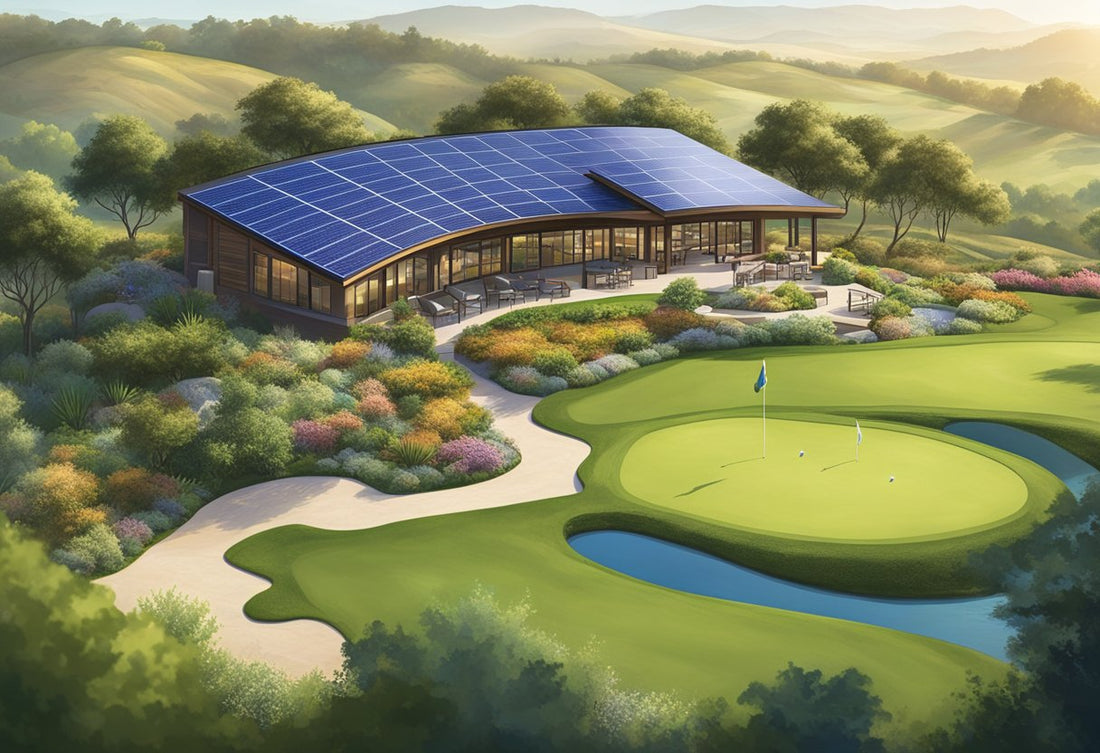Golf is traditionally viewed as a sport of precision and patience, but there is an increasing push from within the community to align this beloved pastime with environmental consciousness. The concept of green fairways is more than just keeping the grass in top condition—it's a comprehensive approach to sustainable golfing practices that respect and preserve the natural landscape. As eco-friendly initiatives gain traction, golfers and courses alike are finding ways to create a greener game that reduces the environmental footprint and even enhances the playing experience.

Environmental stewardship has found a place on the golf course through sustainable landscaping, water conservation, and wildlife protection. In addition, advancements in golfing gear, including the use of biodegradable golf tees and recycled materials, are helping to reduce the waste associated with the sport. The industry is also seeing a rise in eco-friendly golf tournaments that aim to promote sustainability while still providing competitive excitement. These tournaments serve not only as an entertainment platform but also as a showcase for green innovations within the sport, demonstrating that environmental responsibility can go hand in hand with the game's traditions and future developments.
Key Takeaways
- Sustainable practices are becoming integral to modern golf, enhancing both the game and the environment.
- Adoption of green equipment and eco-friendly golf tournament standards is on the rise.
- Golf communities are embracing their role in environmental stewardship, utilizing advances in technology and renewables.
The Green Movement in Golf

The golf community is increasingly embracing environmental stewardship, advocating for practices that preserve and enhance the natural beauty and sustainability of golf courses.
History of Eco-Friendly Golf
The initiative to integrate eco-friendly practices within golf began to gain noticeable traction in the late 20th century. Players and course designers realized the impact that the sport had on natural resources and began seeking ways to reduce its footprint. This movement has led to the adoption of measures such as the use of biodegradable golf tees and the incorporation of natural elements that benefit the ecosystem into course design.
Benefits of Green Fairways
The benefits of green fairways are multifaceted, impacting both the environment and the game itself.
-
Environmental Benefits:
- Reduced water consumption
- Enhanced habitat for wildlife
- Decreased chemical use
-
Gameplay Benefits:
- Improved playability with natural course designs
- Increased awareness and responsibility among players
Responsible turf management and the creation of eco-conscious courses are not only good for the earth but can also add a new strategic element to the game, as noted in the discussions about eco-conscious golf courses. Players enjoy a more natural playing experience while also contributing to global sustainability efforts.
Golf Course Sustainability

Golf courses are taking significant strides towards sustainability by adopting eco-friendly maintenance practices, implementing water conservation techniques, and engaging in wildlife conservation efforts.
Eco-Friendly Course Maintenance
Eco-friendly course maintenance includes the use of organic fertilizers and natural pest control methods to reduce chemical use. For example, some courses make use of compost tea as a sustainable soil amendment to enhance turf health and minimize pesticide reliance.
Water Conservation Techniques
Golf courses are reducing their environmental footprint through water conservation. This can be achieved by planting drought-resistant vegetation and utilizing cutting-edge irrigation systems that maximize efficiency. Studies show that employing eco-friendly management practices can save up to 25% in water usage.
Wildlife Conservation Efforts
Preserving natural habitats for wildlife on and around golf courses is essential for biodiversity. Golf facilities often collaborate with environmental organizations to create sanctuaries for birds, insects, and small mammals, ultimately supporting local ecosystems.
Green Equipment and Gear

Innovations in golf equipment are creating opportunities for players to enjoy the game while being cognizant of their ecological footprint. This section will provide insight into the latest advancements in green golf equipment and apparel, which are designed to minimize environmental impact.
Biodegradable Golf Balls
Biodegradable golf balls offer a more environmentally responsible option as they decompose naturally, reducing the amount of waste left on courses and in natural habitats. Key features include non-toxic materials and they are typically made of natural polymers that enable them to break down within weeks or months, not centuries.
Eco-Friendly Golf Clubs
The production of eco-friendly golf clubs takes into account both the materials and manufacturing processes. Clubs made with sustainable materials such as bamboo or recycled metals not only lessen environmental harm but also meet the performance demands of golfers. Some manufacturers even offer recycling programs to manage end-of-life clubs.
Sustainable Golf Apparel
Sustainable golf apparel utilizes fabrics that are either recycled or sourced from sustainable farms. Companies are becoming more transparent about their supply chains, ensuring that the clothes are produced with ethical labor practices and environmentally safe processes. Fans of golf can find a range of items from shirts and caps to shoes incorporating these eco-conscious principles.
Environmentally Conscious Playing

Incorporating sustainability into golf requires awareness and action on the part of the player. This can involve choices ranging from mode of transportation on the course to waste management.
Walking vs. Golf Carts
- Walking: A golfer who chooses to walk instead of using a cart reduces their carbon footprint. They benefit not only the environment but also their health through added physical activity.
- Golf Carts: If a cart is necessary, opting for a solar-powered or electric model lowers emissions compared to gasoline-powered carts.
Zero Waste Golfing Tips
- Equipment: Choose eco-friendly equipment, such as clubs made from sustainable materials or recycled balls.
- Packaging: Minimize waste by avoiding single-use plastics in packaging and selecting items with biodegradable or recyclable packaging.
Eco-Friendly Golf Tournaments

Eco-Friendly Golf Tournaments are not only about competition but also about embracing environmental stewardship. These tournaments set an example by integrating sustainability into every aspect of event organization.
Planning Green Events
When curating an Eco-Friendly Golf Tournament, the planning committee's focus is intertwined with sustainability. Key considerations include venue selection where natural landscapes are preserved, encouraging the use of recyclable materials, and ensuring transportation for participants is carbon-neutral. For instance, events like participation in eco-friendly golf programs support conservation efforts.
Essential steps in planning:
- Select courses with Eco-Certifications
- Offer digital scorecards to minimize paper waste
- Encourage carpooling or shuttle services for attendees
Promoting Sustainability in Golf Sports
Promotion of sustainability in golf transcends the game itself. It involves educating players, spectators, and sponsors on the importance of environmental preservation. Communication strategies highlight the benefits of eco-friendly turf management and its positive impact on the game's future.
Initiatives for promotion:
- Highlight innovative course designs that contribute to biodiversity
- Market eco-conscious merchandise such as apparel made from recycled materials
- Feature sustainable golf accessories like biodegradable tees in tournament giveaways
By focusing on these aspects, Eco-Friendly Golf Tournaments guide the sports community towards a greener future.
Golf Community and Environmental Stewardship
The golfer's pursuit of the perfect swing is harmonizing with nature's chorus through dedicated environmental stewardship. Increasingly, the golf community is recognizing the importance of eco-friendly practices that benefit both the game and the environment.
Grassroots Movements

Grassroots movements within the golfing community are catalyzing change from the bottom up. Golfers are adopting eco-friendly practices such as using biodegradable tees and advocating for golf course wildlife conservation. These movements often start small but play a pivotal role in transforming local golf courses into sanctuaries of sustainability.
Educational Programs for Golfers
Golf courses and organizations are rolling out educational programs aimed at empowering golfers with knowledge on environmental conservation. By participating in initiatives that teach about water conservation, the choice of maintenance products, and the management of habitats, golfers are becoming stewards of the land they play on. These programs, including on-course tips for protecting ecosystems, are essential for the golfer's informed eco-conscious play.
Renewable Energy in Golf

Golf is adapting to environmental needs by incorporating renewable energy sources, notably in golf cart operations and clubhouse management.
Solar Powered Golf Cart Stations
Golf courses are increasingly investing in solar powered golf cart stations, providing an eco-friendly alternative for transportation on the green. These stations use photovoltaic panels to capture solar energy, which is then used to charge electric golf carts. This transition helps reduce the carbon footprint and reliance on fossil fuels. For instance, some courses have implemented stations that harness the sun's energy, a clean and inexhaustible power source, redefining the golf carts as not just vehicles but mobile embodiments of sustainability. For a practical insight, consider the push towards solar energy or biofuels for powering golf carts.
Wind Energy in Club Operations
Similarly, wind energy is being used to power myriad aspects of club operations — from lighting clubhouse facilities to irrigating the course. This step not only diminishes the environmental impact but may also lead to reduced operational costs in the long run. Clubs that position themselves in windy locales can install turbines, transforming gusts into usable electricity. Such initiatives signal a commitment to stewarding environmental resources responsibly while maintaining the sport's integrity.
Advancements and Innovations

The evolution of golf has been marked by technological advancements and sustainable practices, reshaping both the game and the courses. This section covers the latest in eco-friendly golf technology and what lies ahead for green golfing.
Emerging Eco-Friendly Golf Technology
Recent years have witnessed a surge in eco-friendly innovations in golf. For instance:
- Biomechanics and Golf Analytics: New technology allows for more detailed analysis of a golfer's swing, aiding in both performance improvement and injury prevention without compromising the environment.
- Sustainable Turf Management: Courses are implementing practices that conserve water, reduce chemical use, and preserve local ecosystems, leading to a more environmentally conscious way to maintain fairways.
The Future of Green Golfing
Looking forward, the future of golf seems to be leaning heavily towards sustainability.
- Eco-Conscious Course Designs: Architects are embracing the environment in their designs, which not only supports conservation but also offers new challenges and strategic play for golfers.
- Participation and Advocacy: There is a growing trend towards hosting and participating in eco-friendly golf events, leading to wider awareness and adoption of green practices within the golfing community.
Frequently Asked Questions

This section addresses common inquiries about the intersection between golf and environmental sustainability, focusing on actionable insights and practices.
How can golf courses contribute to environmental sustainability?
Golf courses can foster sustainability by implementing sustainable turf management practices, using natural water sources responsibly, and enhancing habitats for local wildlife.
What are the best practices for maintaining eco-friendly golf fairways?
To maintain eco-friendly golf fairways, courses should employ organic fertilizers, limit pesticide use, and implement integrated pest management strategies that focus on the health of the turfgrass ecosystem.
Which types of grass are ideal for creating a more eco-friendly golf course?
Grasses that are native to the region or have low water requirements are ideal for an eco-friendly golf course, as they are more sustainable and require fewer resources to maintain.
What role do golfers play in promoting an eco-friendly golfing environment?
Golfers contribute to a greener golfing environment by adopting habits such as using biodegradable golf tees and supporting golf courses that employ eco-friendly practices.
How does the maintenance of greens differ from fairways in terms of eco-friendliness?
Maintaining greens often requires a more intensive approach due to their delicate nature, with careful consideration for mowing, watering, and the use of fertilizers to ensure they align with eco-friendly standards, while fairways can be managed with broader environmental practices.
Can the design of a golf course impact its environmental sustainability?
Yes, the design of a golf course can significantly influence its sustainability by integrating features such as natural landscaping that support biodiversity and reduce water usage, and by planning the layout to work with the natural environment rather than against it.


